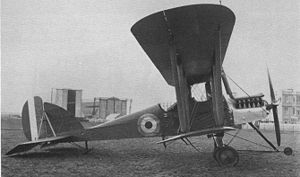Royal Aircraft Factory R.E.7 Video - Picture

|
|
Royal Aircraft Factory R.E.7
Royal Aircraft Factory R.E.7

Picture - RAF 4a powered R.E.7
Role: Light bomber and reconnaissance biplane
Manufacturer: Royal Aircraft Factory
First flight: 1915
Introduced: 1915
Primary user: Royal Flying Corps
Number built: 230
Developed from: Royal Aircraft Factory R.E.5
The Royal Aircraft Factory R.E.7 was a British two-seat light bomber and reconnaissance biplane designed by the Royal Aircraft Factory and built under contracts by the Coventry Ordnance Works, Austin, Napier and Siddeley-Deasy for the Royal Flying Corps.
Development
Developed from the R.E.5 the R.E.7 was designed to carry heavier loads and also suitable for escort and reconnaissance duties. It was an-unequal span biplane with a fixed tailskid landing gear and powered by a nose-mounted 120hp (89kW) Beardmore engine driving a four-bladed propeller. The aircraft was built by a number of different contractors with the first aircraft operational with the Royal Flying Corps in France in early 1916. The aircraft had two open cockpits with the observer/gunner in the forward cockpit under the upper wing and the pilot aft.
Operational history
It was soon found that the aircraft could not be used as an escort due to the limited field of fire for the single lewis gun but the R.E.7 had a useful payload and was soon used as a light bomber with the a more powerful engine (either a 150hp (112kW) RAF 4a or 160hp (119kW) Beardmore). Over a quarter of the aircraft built were used in France in the middle of 1916 but their slow speed and low ceiling with a bomb load made them vulnerable to attack. The R.E.7s were withdrawn and used for training and a number were used as engine test beds. Use was made of them as target tugs trailing a sleeve drogue for air-to-air firing practice, probably one of the first aircraft to do this.
At least two R.E.7s were converted to three seaters.
Operator
United Kingdom
Royal Flying Corps
No. 9 Squadron RFC
No. 12 Squadron RFC
No. 19 Squadron RFC
No. 20 Squadron RFC
No. 21 Squadron RFC
No. 37 Squadron RFC
No. 49 Squadron RFC
Specifications (light bomber)
Data from The Illustrated Encyclopedia of Aircraft (Part Work 1982-1985). Orbis Publishing. pp. 2820.
General characteristics
Crew: 2 (pilot, observer/gunner)
Length: 31 ft 10½ in (9.72 m)
Wingspan: 57 ft 0 in (17.37 m)
Height: 12 ft 7 in (3.84 m)
Wing area: 548 ft² (50.91 m²)
Empty weight: 2285 lb (1036 kg)
Gross weight: 3450 lb (1565 kg)
Powerplant: 1 x— RAF 4a Vee piston engine, 150 hp (112 kW)
Performance
Maximum speed: 84 mph (135 km/h)
Endurance: 6 hours 0 min
Service ceiling: 6,500 ft (1980 m)
Armament
1 x 336lb (152kg) bomb or
smaller bombs up to 324lb (147kg)
Taylor, Michael J. H. (1989). Jane's Encyclopedia of Aviation. London: Studio Editions.
The Illustrated Encyclopedia of Aircraft (Part Work 1982-1985). Orbis Publishing. pp. 2820.
British Aircraft Directory
Royal Aircraft Factory R.E.7 Pictures
Living Warbirds: The best warbirds DVD series.
Source: WikiPedia